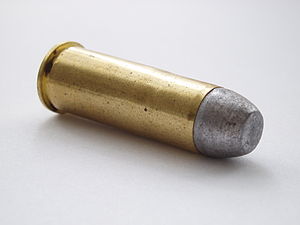
Back .44-40 Winchester Breton .44-40 WCF German .44-40 Winchester Spanish .44-40 WCF French .44-40 NB .44-40 Winchester Portuguese .44-40 Winchester Russian .44-40 Winchester Ukrainian
| .44-40 Winchester | ||||||||||||||||||||
|---|---|---|---|---|---|---|---|---|---|---|---|---|---|---|---|---|---|---|---|---|
 .44-40 Winchester cartridge | ||||||||||||||||||||
| Type | Rifle, revolver | |||||||||||||||||||
| Place of origin | United States | |||||||||||||||||||
| Production history | ||||||||||||||||||||
| Designer | Winchester Repeating Arms Company | |||||||||||||||||||
| Designed | 1873 | |||||||||||||||||||
| Produced | 1873–present | |||||||||||||||||||
| Specifications | ||||||||||||||||||||
| Case type | Rimmed, bottleneck | |||||||||||||||||||
| Bullet diameter | .427 in (10.8 mm) | |||||||||||||||||||
| Neck diameter | .443 in (11.3 mm) | |||||||||||||||||||
| Shoulder diameter | .458 in (11.6 mm) | |||||||||||||||||||
| Base diameter | .471 in (12.0 mm) | |||||||||||||||||||
| Rim diameter | .525 in (13.3 mm) | |||||||||||||||||||
| Rim thickness | .065 in (1.7 mm) | |||||||||||||||||||
| Case length | 1.305 in (33.1 mm) | |||||||||||||||||||
| Overall length | 1.592 in (40.4 mm) | |||||||||||||||||||
| Case capacity | 40 gr H2O (2.6 cm3) | |||||||||||||||||||
| Primer type | Large pistol | |||||||||||||||||||
| Maximum pressure | 11,000 psi (75.84 MPa)[1] | |||||||||||||||||||
| Maximum CUP | 13,000[2] CUP | |||||||||||||||||||
| Ballistic performance | ||||||||||||||||||||
| ||||||||||||||||||||
| Test barrel length: 20" Source(s): Reloadersnest.com | ||||||||||||||||||||
The .44-40 Winchester (10.8x33mmR), also known as .44 Winchester, .44 WCF (Winchester Center Fire), and .44 Largo (in Spanish-speaking countries), was introduced in 1873 by the Winchester Repeating Arms Company. It was the first metallic centerfire cartridge manufactured by Winchester, and was promoted as the standard chambering for the new Winchester Model 1873 rifle.[3][4] As both a rifle and a handgun caliber, the cartridge soon became widely popular, so much so that the Winchester Model 1873 rifle became known as "The gun that won the West."[5]
- ^ SAAMI – rifle. Sleeping Dog Ammo. (n.d.). https://www.sleepingdogammo.com/saami-rifle/
- ^ Saami pressures. (n.d.). Retrieved May 3, 2023, from https://leverguns.com/articles/saami_pressures.htm
- ^ "The 44-40 (44WCF) for beginners (like me)" Leverguns Web site.
- ^ "The .44-40 Winchester". Guns and Ammo. Archived from the original on 29 June 2008. Retrieved 28 March 2022.
- ^ Madis, George (1971). The Winchester book ([1st ed.] ed.). Lancaster, Tex.: Art and Reference House. ISBN 978-0910156035.